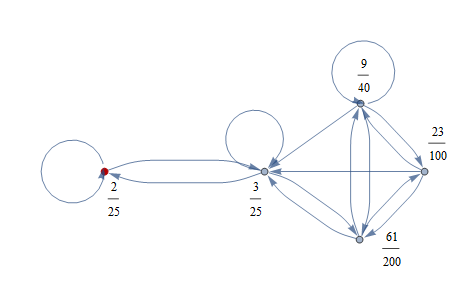"Let $\{X_n, n \geq 0\}$ be a DTMC with state space $S = \{1, 2, 3, 4, 5\}$ and the following transition probability matrix:
$$ P = \begin{pmatrix} 0.1 & 0.0 & 0.2 & 0.3 & 0.4 \\ 0.0 & 0.6 & 0.0 & 0.4 & 0.0 \\ 0.2 & 0.0 & 0.0 & 0.4 & 0.4 \\ 0.0 & 0.4 & 0.0 & 0.5 & 0.1 \\ 0.6 & 0.0 & 0.3 & 0.1 & 0.0 \end{pmatrix} $$
with the initial distribution as:
$$ a = \begin{pmatrix} 0.5 & 0 & 0 & 0 & 0.5 \end{pmatrix}. $$
Compute $P(X_2 = 2, X_4 = 5)$"
Also, how do I do this? I'm not even sure what it means. Is this asking me to work out the probability of $X_4 = 5$ given that I have $X_2 = 2$?
EDIT: The matrix is correct. From the previous part of the question (that I didn't post), $P(X_2 = 2) = 0.08$. In the answers, my lecturer uses the Chapman Kolmogorov equations. Does this make the answer any clearer?
EDIT 2: Edited to bump to the top as I have commented on whuber's post with a couple of questions




